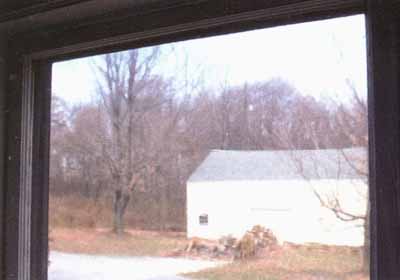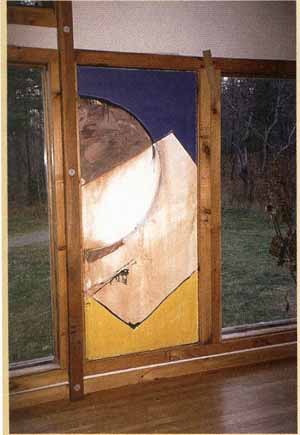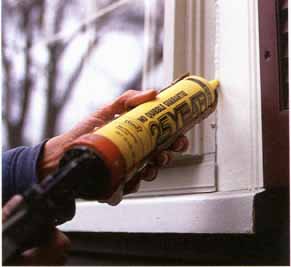Installing new windows
Replacing the entire unit, jamb and all, offers some advantages over sash replacement. Foremost, new units often let in more light, because they don’t have the extra frame thickness that’s common with replacement units. Although replacing the frame requires a lot more trimwork, it’s also an opportunity to get a good look at the house’s framing to see whether there is any damage from leaking water. It is also much easier to seal weight pockets when the interior casing has been completely removed. Of course, adding new trim is significantly less trouble if you are also doing major renovation work on the interior or exterior.
If your existing windows are horizontal sliders, casements, or awning units, replacing the entire window will likely be your only option. However, existing double-hung windows can be replaced with a different-style unit to change the feel of the house or increase or decrease the view opening.
SAFETY ISSUE! When setting a replacement window in place, have a helper on hand. Replacement units that don’t have nailing flanges or trim attached can accidentally push right through the opening and fall out the other side. As always, use caution when working on ladders. To get a window to an upper story (if you can’t set it from inside), set up two ladders and have another helper carry the window up with you.
Improving Existing Windows
Short of replacing windows, you may be able to improve their performance significantly—and for a lot less than it would cost to replace them. On one end of the spectrum are the plastic interior storms that you can shrink-wrap onto the window with a hair dryer, as well as the reusable types with a plastic zip strip. Those “renter’s” storm windows cost very little and are moderately effective for old, rattling single-pane windows, but they are not very practical or aesthetically pleasing. In many cases, older windows can be successfully weatherstripped, and adding storm windows can be a cost-effective improvement if your budget rules out replacement windows.

Interior plastic storm windows may save some energy, but
they don’t do anything for a house’s value or appearance. This one
has a reusable plastic zip strip to hold it in place.

Installing a pulley seal over the rope and pulley of old
double-hung windows is one way to save a little bit of energy, and
it is inexpensive and easy to do.

Adhesive vinyl v-seal weather stripping can be applied
to a window frame to reduce air leak age. Cut the weather-stripping
to fit, press it in place between the sash and the frame, and peel
the paper off the adhesive backing around the edge of the window.
Improving old double-hung windows
The classic rope-and-pulley double-hung wood window is a very elegant design that is simple, functional, and repairable. In a drafty, uninsulated wood frame house, they provide light, views, and ventilation without appreciably affecting the house’s energy performance. But as the years pass, the wood sash loosens and layers of paint disrupt their fit and operation. Once you effectively insulate and air-seal the building, they become a potentially large energy liability
If you aren’t ready to replace them, rattling window sashes can be tightened with leaf-type or v-seal weather-stripping and pulley seals. In many cases, simply removing excess paint so that the sashes meet properly and the sash locks work can make a big difference in their performance.
TIP: New storm windows won’t save as much energy as new, airtight, Low-e replacement windows, but their cost is relatively low
MORE DETAILS: For years, passive solar and energy-efficiency guides have advocated the use of movable insulation to reduce nighttime heat loss. Effective when used properly, movable insulation saves energy—but at the price of human energy. Insulation also cools the glass, so it must fit snugly; if indoor air touches the cold glass, condensation can result. Panels must be stored during the day; insulating shades on roller tracks are finicky and often fail.


An exterior storm sash (left) is still a viable option, particularly
for a traditional home. The holes at the bottom are vents to let moisture
escape, and they are mostly covered by an adjustable stop. Clip-on storm
panels (above) with aluminum- or vinyl-edge trim can be permanently installed
over fixed picture windows and casement windows.
Storm windows
Adding storm windows to single-pane glass will reduce the heat loss through the windows by about 50%, in addition to reducing interior condensation and frost, so this project may be worth it. However, storm windows are generally not as attractive as replacement windows, they don’t add as much to the resale value of a house, and they increase the hassle of window cleaning and maintenance. They will not save as much energy as new, airtight, Low-e replacement windows, but they are relatively inexpensive.
Storm windows have been around since the 19th century. Typically, they were fixed panels that were installed seasonally on the exterior of windows. That approach is still an option; a skilled do-it-yourselfer with a decent shop can probably make them for less than the cost of triple—track aluminum storm windows, and they will look much better. If they are carefully made, they will fit much more tightly and not have leaky, movable sashes that allow air through. However, they aren’t as flexible—you can’t just decide to open them on a mild day. They must be installed and removed every winter and stored somewhere during the summer. If you do decide to make storm panels, try to get hard-coat Low-c glass for better performance. It’s a special order from a glass shop, but the better performance is worth the trouble.
Large picture windows and other fixed-sash glass may also be treated with permanent, fixed storm sashes. In very large openings, Plexiglas, acrylic, or polycarbonate may be more affordable than glass, which must be tempered for safety. And the only way to add storm panels to casement or awning windows is with clip-on panels that open and close with the sash.
Today most people who install storm windows choose triple—track aluminum combination units, with movable sashes and screens all in one pack age. If you do invest in those windows, be sure to get ones with low—leakage ratings (less than 0.3 cfm per ft.), and try to find Low-c glass. Regular Low-c coatings used in sealed, double-glass windows are soft and can’t be exposed to weather or handling, but there are special hard-coat Low-e products that hold up well. When installing storm windows, follow the manufacturer’s instructions carefully, and don’t use any glues or sealants until the frame is screwed firmly in place and you can verify that all the sashes and screens operate smoothly
With any storm window application, make sure that any moisture that gets between the primary window and the storm can escape, or you may get condensation on the inside surface of a cold storm window In practice, this means that the storm window must be at least a bit leakier than the primary window Therefore, if your primary window is very leaky you will need to improve the weather-stripping, or the storm won’t help very much. Controlling indoor relative humidity during the winter can also help, because that reduces the amount of moisture in indoor air.
Other strategies to improve window performance

Be sure to caulk around the frames of new storm windows
to maximize their benefit. Remember: It’s important to leave the weep
holes at the sill open, so any moisture that collects there can drain
freely.
A number of other strategies can improve window performance without changing or treating the windows or glass directly. In cold climates, drapes or movable insulation can reduce heat loss in winter. If you are diligent, night insulation can be very effective, but few people want to move insulation panels twice a day
Also, be aware of the effect of shading on south-facing windows. The branches of deciduous trees, often touted as providing beneficial shade in summer while allowing solar gain in winter, actually diminish solar radiation by about half and should be avoided near the south side of a house. Even insect screens on the south side should be removed in winter, because they also cut solar gain significantly on the cooling side, even more can be done to decrease air-conditioning loads. Although shades and blinds on the inside significantly reduce solar gains, external shading is even more effective, because the sun’s rays never even hit the glass. Shading that is built onto the house—overhangs, awnings, or porches—or nearby, such as trellises, arbors, and other structures, can prevent or reduce solar heat gain.
Landscaping choices, such as trees and other plantings, can also shade windows. You can shade east- and west-facing windows in any climate to reduce cooling loads, and overhangs can be as deep as you like. It is a little more complicated on the south side of a house. In a hot climate, shading south-facing windows will also help cut cooling loads. In a mixed or cold climate, shading the south side reduces cooling loads, but at the expense of also reducing free solar energy in winter. Moderate overhangs attached to the building right above the windows are the best choice. If they are properly sized, they will admit solar rays in winter, when the sun’s angle is low in the sky and still shade windows in summer, when the sun is overhead.
Next: Heating Systems